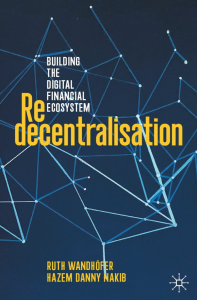
Redecentralisation is not a word that rolls off the tongue. It sounds like a buzzword that has been mangled by business speak, but after reading Redecentralisation – Building The Digital Financial Ecosystem, it will make sense to those who are disciplined enough to read through it.
Co-written by technologists Ruth Wandhöfer and Hazem Danny Nakib, the book is a detailed guide to how finance works, how it used to work and how it’s going to work in the future.
The authors explain that early humans were naturally decentralised in small groups until evolution took over and humans embraced centralisation to be safe.
The financial world we live in now is going back to a looser, more individual experience and systems will reflect this.
I enjoyed this immensely. I wasn’t aware of the term redecentralisation, but from the first paragraph I knew I was in the hands of two experts. It brings together past, present and future financial systems and explains how Web3, blockchain, crypto and AI are going to change everything.
While preaching to this reader as the converted, I learnt about how financial legacy systems work at the heart of global commerce and alien acronyms finally made sense. It made me think about how the metaverse will finally become part of our everyday lives and why crypto is not a fad and Bitcoin is a fascinating technology that defines blockchain and it’s verification of trust.
I also trusted the authors who have a deep understanding of how money works and why’s it’s now so important that people are ready for the disruption that the next force of technology change will bring.
I am now better prepared for the future; always a good sign from a business book, although that future may become extremely daunting for this who refuse to change their ideas. Recommended.



